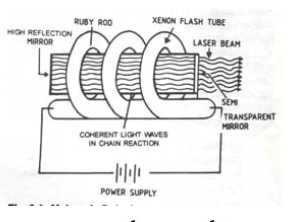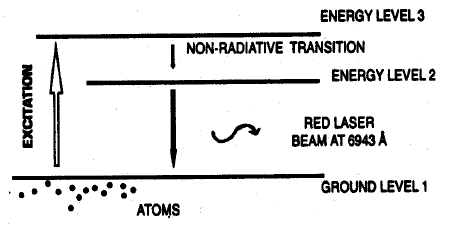Ruby Laser
Ruby Laser: Ruby laser is historically the first one to be discovered; It gives laser radiation on a pulsed length (1 nm = 10-9 m). It consists of a ruby rod xenon flash tube, a suitable cavity to reflect the light from flash tube to the ruby rod, and a high voltage power supply to give electrical energy to the flash tube. Maiman's laser set-up is shown in Fig. 1. During his experiment, Maiman found that the ideal composition for the ruby crystal is five atoms of chromium for every ten thousand atoms of aluminum, i.e., a concentration of 0.05 percent. The ruby rod used was 4 cm long and 1/2 cm in diameter and the ends were ground to a high degree of flatness and parallelism. One end was silvered making it a mirror (almost 100 percent reflective) to reflect all the rays of light striking it. The other end of the rod was partially silvered; the laser beam was emitted through that end. The ruby rod was surrounded by a helical xenon flash lamp and both of them were held inside a cylindrical cavity, coated with a reflective material. The light from the xenon flash tube was focused by the cylindrical cavity onto the ruby rod, thereby exciting the chromium atoms which were responsible for the laser action The ruby laser is a three-Level system since only three energy levels


are involved in the process of stimulated emission. The depopulation of the ground state for population inversion is achieved by exciting the atoms of the ruby crystal with intense light from a xenon flash lamp. Thus the atoms are excited from the ground state (level 1) to an upper state (level 3) by means of absorption. From the energy level 3, the atoms are transferred to energy level 2 without emitting radiation (non-radiative transfer). The energy level 2 is called met stable level since the atoms stay at this level for a longer interval of time. Finally, the atoms return to the ground state from the met stable level through the process of stimulated emission giving rise to an intense laser light at 6943A. The laser beam comes out in the form of a pulse of very short duration (about a millisecond). The continuous wave operation of the system is very difficult to achieve. Only 1 to 2 per cent of the input is utilized to obtain the laser action. The rest is dissipated
as heat and is therefore wasted. In Q-switched mode, the power up to 500 MW has been achieved. Since this laser requires consider able input energy to give laser action, it is now being used only for limited applications in the areas of holography, high speed photography, etc.